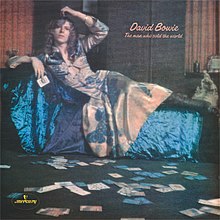The Man Who Sold the World (album)
| The Man Who Sold the World | ||||
|---|---|---|---|---|

1970 American release
|
||||
| Studio album by David Bowie | ||||
| Released | 4 November 1970 | |||
| Recorded | 18 April – 22 May 1970 | |||
| Studio | Trident Studios in London and Advision Studios in West London | |||
| Genre | ||||
| Length | 40:29 | |||
| Label | Mercury | |||
| Producer | Tony Visconti | |||
| David Bowie chronology | ||||
|
||||
| Alternative covers | ||||

1971 British LP
|
||||

1971 German LP
|
||||

1972 RCA LP
|
||||
| Professional ratings | |
|---|---|
| Retrospective reviews | |
| Review scores | |
| Source | Rating |
| AllMusic | |
| Chicago Tribune | |
| Encyclopedia of Popular Music | |
| Music Story | |
| MusicHound Rock | 4/5 |
| Pitchfork | 8.5/10 |
| Q | |
| The Rolling Stone Album Guide | |
| Spin | |
| Spin Alternative Record Guide | 5/10 |
The Man Who Sold the World is the third studio album by English rock artist David Bowie. It was originally released in the United States by Mercury Records on 4 November 1970, and then in April 1971 in the United Kingdom. He recorded the album with producer Tony Visconti at Trident Studios in London and Advision Studios in West London.
Though author David Buckley has described Bowie's previous record David Bowie (Space Oddity) as "the first Bowie album proper",NME critics Roy Carr and Charles Shaar Murray have said of The Man Who Sold the World, "this is where the story really starts". Departing from the largely acoustic music of Bowie's second album,The Man Who Sold the World is generally considered a hard rock and heavy metal album.
The album was written and rehearsed at David Bowie's home in Haddon Hall, Beckenham, an Edwardian mansion converted to a block of flats that was described by one visitor as having an ambiance "like Dracula's living room". As Bowie was preoccupied with his new wife Angie at the time, the music was largely arranged by guitarist Mick Ronson and bassist/producer Tony Visconti. Although Bowie is officially credited as the composer of all music on the album, biographer Peter Doggett quoted Visconti saying "the songs were written by all four of us. We'd jam in a basement, and Bowie would just say whether he liked them or not." In Doggett's narrative, "The band (sometimes with Bowie contributing guitar, sometimes not) would record an instrumental track, which might or might not be based upon an original Bowie idea. Then, at the last possible moment, Bowie would reluctantly uncurl himself from the sofa on which he was lounging with his wife, and dash off a set of lyrics." Despite his annoyance with Bowie's fixation on married life during the recording of The Man Who Sold the World, Visconti still rated it as his best work with Bowie until 1980's Scary Monsters (And Super Creeps).
...
Wikipedia
